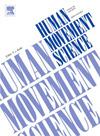关注过程还是结果?这取决于任务目标。
IF 1.9
3区 心理学
Q4 NEUROSCIENCES
引用次数: 0
摘要
大量的研究支持外部焦点相对于内部焦点增强运动表现。然而,这种笼统的建议忽略了哪些类型的外部线索可能是最有效的。一些研究比较了近端和远端外焦,但这种比较经常被空间和时间距离的差异所混淆。在本研究中,我们的目的是确定内部和外部焦点线索如何将注意力引导到运动的过程或结果(即,不同的时间距离,但不是空间距离)影响内六角杆硬举的表现。24名有力量训练经验的参与者(16名女性)进行了六杠硬举,其中60%的人自我报告的1RM。在熟悉性试验之后,以平衡顺序呈现内部过程(IP)、内部结果(IO)、外部过程(EP)和外部结果(EO)焦点。峰值速度、平均速度和竖杆位移采用重复测量方差分析(anova)来检验因聚焦而产生的差异。峰值速度受到焦点的影响,EP导致的值高于IO和IP。平均流速EP值高于IO值,且接近于IP值。对于竖杆位移,EO导致的位移大于IO和IP,但与EP没有差异。目前的研究结果表明,EP在提高速度(主要目标)方面最有效,而EO在最大位移方面最有效。这些不同的发现表明,最好的外部注意力线索是那些与重要任务目标最密切相关的线索。本文章由计算机程序翻译,如有差异,请以英文原文为准。
Focus on the process or outcome? It depends on the task goal
An abundance of research supports an external focus enhancing motor performance relative to an internal focus. However, this blanket recommendation loses some nuance of what types of external cues might be most effective. Some studies have compared a proximal and distal external focus, but this comparison is often confounded by differences in both spatial and temporal distance. In the present study, we aimed to determine how internal and external focus cues that direct attention to either the process or outcome of the movement (i.e., differing in temporal distance, but not spatial distance) impacted hex bar deadlift performance. Twenty-four participants (16 females) experienced in strength training performed hex bar deadlifts with 60 % of their self-reported 1RM. Familiarization trials were followed by conditions using an internal-process (IP), internal-outcome (IO), external-process (EP), and external-outcome (EO) focus presented in a counterbalanced order. Peak velocity, average velocity, and vertical bar displacement were subjected to repeated measures ANOVAs to test for differences due to focus. Peak velocity was impacted by focus with an EP leading to higher values than IO and IP. For average velocity EP had higher values than IO, and approached higher values than IP. For vertical bar displacement, EO led to greater displacement than IO and IP, but did not differ from EP. The present findings suggest EP was most effective for enhancing velocity (primary goal), but EO maximized displacement. These differing findings suggest that the best external focus cues are those which most closely align with important task goals.
求助全文
通过发布文献求助,成功后即可免费获取论文全文。
去求助
来源期刊

Human Movement Science
医学-神经科学
CiteScore
3.80
自引率
4.80%
发文量
89
审稿时长
42 days
期刊介绍:
Human Movement Science provides a medium for publishing disciplinary and multidisciplinary studies on human movement. It brings together psychological, biomechanical and neurophysiological research on the control, organization and learning of human movement, including the perceptual support of movement. The overarching goal of the journal is to publish articles that help advance theoretical understanding of the control and organization of human movement, as well as changes therein as a function of development, learning and rehabilitation. The nature of the research reported may vary from fundamental theoretical or empirical studies to more applied studies in the fields of, for example, sport, dance and rehabilitation with the proviso that all studies have a distinct theoretical bearing. Also, reviews and meta-studies advancing the understanding of human movement are welcome.
These aims and scope imply that purely descriptive studies are not acceptable, while methodological articles are only acceptable if the methodology in question opens up new vistas in understanding the control and organization of human movement. The same holds for articles on exercise physiology, which in general are not supported, unless they speak to the control and organization of human movement. In general, it is required that the theoretical message of articles published in Human Movement Science is, to a certain extent, innovative and not dismissible as just "more of the same."
 求助内容:
求助内容: 应助结果提醒方式:
应助结果提醒方式:


